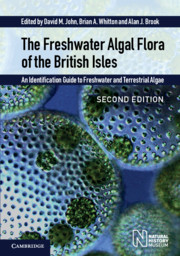 The Freshwater Algal Flora of the British Isles
The Freshwater Algal Flora of the British Isles Published online by Cambridge University Press: 12 January 2024
Introduction
The red algae constitute a division (phylum) of organisms that share the following combination of attributes: eukaryotic cells, lack of flagella, floridean starch, phycobiliprotein pigments, unstacked thylakoids, and chloroplasts lacking an external endoplasmic reticulum (Woelkerling, 1990). They are primarily marine, with only approximately 3% of the over 6102 species in truly freshwater habitats (Sheath, 1984; Guiry and Guiry, 2010). Most of the inland red algae are restricted to streams and rivers (Sheath and Hambrook, 1990). A small number occur in habitats other than typical freshwaters, such as soils (Geitler, 1932b) and caves (Hoffmann, 1989). There are monographic- type publications on freshwater red algae from continental Europe worth consulting, including Israelson (1942) –, Eloranta and Kwandrans (2007) and Eloranta et al. (2011). Kumano (2002) provides a comprehensive compilation of taxonomic studies worldwide.
Vegetative Morphology
Most of the red algae in freshwater habitats tend to be macroscopic and benthic (Sheath andHambrook, 1990). Nonetheless, these algae exhibit a smaller size range than do marine species, with 80% of freshwater red algae having a length range of 1–10 cm (the same percentage of marine species ranges up to 30 cm). There are 22 species recorded from the British Isles that are currently accepted, of which 9 are gelatinous filaments (Batrachospermum, Pl. 40A; Sirodotia, Pl. 41F; Thorea, Pl. 43F), 3 are free filaments without a prominent gelatinous matrix (Compsopogon, Pl. 39F; Bangia, Pl. 35B– D; Balbiania, Pl. 36D–F), 3 are pseudoparenchymatous forms (Lemanea, Pls. 42C–E, 43A,B; Paralemanea, Pl. 43C–E), 2 are tufts of short radiating filaments without a common matrix (Audouinella, Pl. 35E,F; 36A–C), 2 are unicells (Porphyridium, Pl. 34D,E), and there is one each of a pseudofilament consisting of loose chains of cells held together with a common gelatinous matrix (Chroodactylon, Pl. 34A,B), a colony with stalked unicells (Chroothece, Pl. 34C), and a crust of a flat thallus composed of compacted tiers of cells (Hildenbrandia, Pl. 44B,C). Among the filamentous forms only Thorea has multiaxial growth (Pl. 44A); the rest are uniaxial, except Bangia, which has a uniaxial base and multiaxial apex at maturity (Pl. 35B,C). Compsopogon has uniaxial filaments that are covered by a layer of small cortical cells (Pl. 35A).
The various morphological forms encounter the stress caused by flow in riverine habitats in different ways, according to Sheath and Hambrook (1988, 1990). Crusts and short tufts occur within the boundary layer or at least in a region of reduced current velocity and hence avoid much of the flow-related stress.
To save this book to your Kindle, first ensure [email protected] is added to your Approved Personal Document E-mail List under your Personal Document Settings on the Manage Your Content and Devices page of your Amazon account. Then enter the ‘name’ part of your Kindle email address below. Find out more about saving to your Kindle.
Note you can select to save to either the @free.kindle.com or @kindle.com variations. ‘@free.kindle.com’ emails are free but can only be saved to your device when it is connected to wi-fi. ‘@kindle.com’ emails can be delivered even when you are not connected to wi-fi, but note that service fees apply.
Find out more about the Kindle Personal Document Service.
To save content items to your account, please confirm that you agree to abide by our usage policies. If this is the first time you use this feature, you will be asked to authorise Cambridge Core to connect with your account. Find out more about saving content to Dropbox.
To save content items to your account, please confirm that you agree to abide by our usage policies. If this is the first time you use this feature, you will be asked to authorise Cambridge Core to connect with your account. Find out more about saving content to Google Drive.